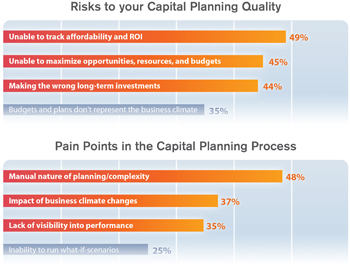Is it sustainable (or dare I say smart) to be planning millions of dollars of capital investments using spreadsheets and manual processes? According to a new study of 125 financial executives responsible for capital planning, the answer is no. In fact, 49% of respondents said their top pain point associated with capital planning is the manual process of using spreadsheets along with its complexity. Nearly half stated their top risks include the inability to track affordability and ROI and maximize opportunities, resources, and budgets. I think about those numbers and it strikes me as unsustainable to continue the status quo of capital planning with spreadsheets.
In the next couple of blog posts, I will drill down on what we discovered in the study and why several related phenomenon should be of concern for those involved in capital investment planning. To begin the conversation this post will address a significant finding that today’s companies are in a near constant state of planning.
A Constant State of Planning
We all know masters of spreadsheets; people who are able to perform complex functions with macros that make it a very powerful tool.
Full disclosure: I love spreadsheets and even my kids know that a quick analysis on a spreadsheet will help them bargain with me. However, let us dig a little deeper into why our favorite tool may no longer be sustainable to meet the challenges and requirements of capital financial planning in today’s business world.
One of the objectives of the study was to determine how rapid business change affects financial planning and we found that the frequency of capital planning is changing a great deal.
In the past, most companies were in a rhythm of annual capital planning with minor adjustments on a quarterly basis. Today, companies are in a near constant state of planning due to economic pressures and rapid change. As indicated in the chart below, 25% of respondents are in an ongoing state of planning and 51% are engaged in it on a quarterly basis. Even those companies that still had traditional annual budget cycles were more apt to revise their plans more frequently.
We originally suspected the findings would indicate planning is an ongoing process but we were surprised to see the just how much the planning process has shifted. Consequently, companies need to develop the discipline of portfolio management on an ongoing basis. This starts with planners having access to data at the ready. In this dynamic environment, companies need to minimize time spent collecting and preparing data and more time analyzing on demand metrics and information. The critical questions become, “How much time is spent collecting data in spreadsheets?”, “How much time is it taking finance resources?” and “How efficient is it?”
From all indications in the study, this access to on-demand, accurate data is limited and the ability to what if scenarios and modeling is not available to planners. The top pain point being the manual nature of planning and its complexity is especially acute in this environment. It links directly with the top risks of not being able to measure investments and concern that the right investments are taking place from the start.
The bottom line is this; companies that are in a constant state of planning need better information technology tools to manage their capital planning process.
We still have a lot of interesting information to cover from this research. Next time we will hear from Madison Laird and get his thoughts and insight about ‘Level of Structure’ in capital planning its impact, and more.
Do you want to read the full report? Get The State of Capital Planning and discover ways to improve your capital planning process.




